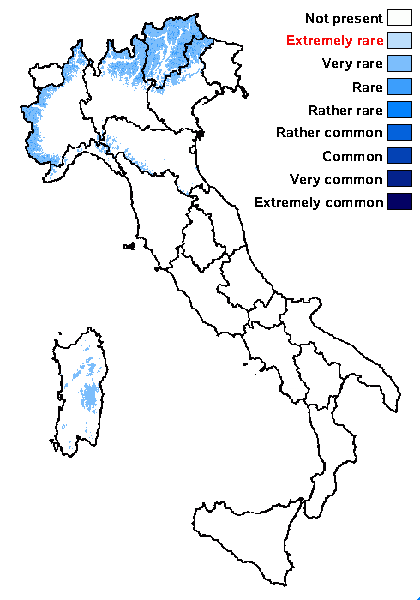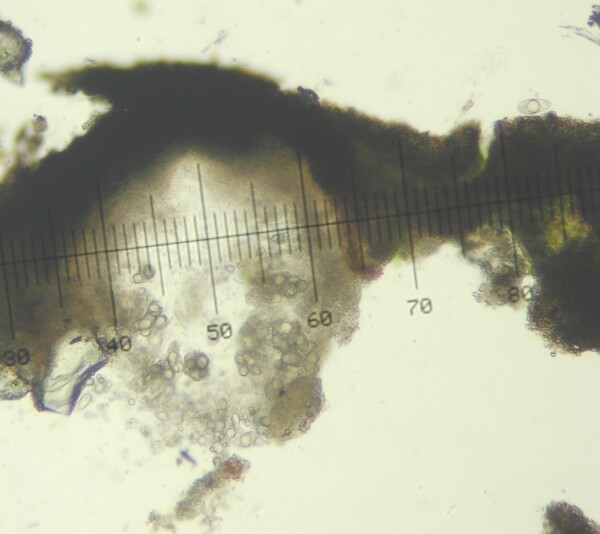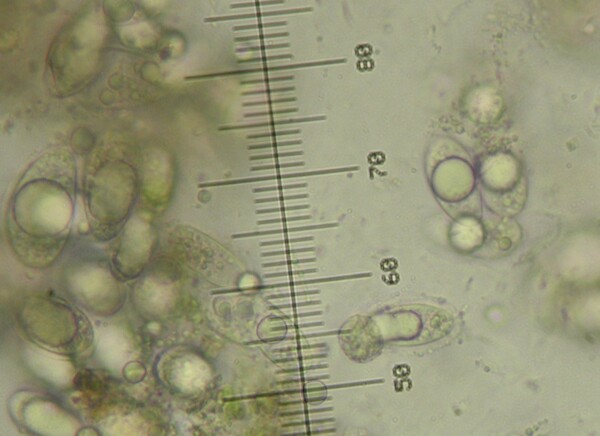Verrucaria latebrosa Körb.
Syst. Lich. Germ.: 349, 1855.
Synonyms: Verrucaria delita Nyl.; Verrucaria griseocinerascens (Vain.) Zschacke
Distribution: N - Ven, TAA (Thor & Nascimbene 2007, Nascimbene & al. 2007b, 2022), Lomb, Piem (Isocrono & al. 2004), Emil, Lig (Watson 2014). C - Sar.
Description: Thallus crustose, episubstratic, not subgelatinous when wet, 60-85 μm thick, grey-green, dark brown to pale grey-brown both when dry and when wet, continuous or cracked-areolate, smooth, matt to slightly shiny, delimited by a pale prothallus. Cortex poorly developed, with a brown pigment; algal layer 60-100 μm thick; medulla para- to prosoplectenchymatous, without a dark basal layer. Perithecia 1(-2) per areole, covered by a thalline layer except in the black apical part, forming low to moderate, 0.25-0.5 mm wide projections; involucrellum thick, limited to the apex of the exciple or spreading in upper half, rarely reaching to base-level in damaged specimens; exciple 0.195-0.3(-0.39) mm across, the wall colourless or almost so in lower part; hamathecium of up to 25 μm long periphyses and periphysoids, interascal filaments absents; hymenial gel hemiamyloid, I+ red (I+ blue at very low concentrations of I), K/I+ blue. Asci 8-spored, clavate, I-, fissitunicate, the wall thickened above, with an ocular chamber, dehiscent by extrusion of an endotunica to form a delicate rostrum, Verrucaria-type. Ascospores 1-celled, hyaline, ellipsoid, (18-)27-30(-37) x 8.5-12.5(-14.8) μm, surrounded by a gelatinous perispore (fresh material!). Photobiont chlorococcoid, the cells not arranged in vertical columns. Spot tests: K-, C-, KC-, P-, UV-. Chemistry: without lichen substances.
Note: a freshwater species, periodically submerged on hard siliceous rocks, occasionally also on calcareous substrata, mostly in upland areas. Most of the earlier Italian records need confirmation. The species was included in V. aethiobola by Orange (2013) as a member of a “collective species”, and its relation to V. anziana has to be clarified. No material from the type locality has been sequenced, which may be necessary to select a sequenced epiptype to fix the ambiguous use of this name (Thüs in litt.). See also note on V. anziana.
Growth form: Crustose
Substrata: rocks
Photobiont: green algae other than Trentepohlia
Reproductive strategy: mainly sexual
Periodically submerged (e.g. in creeks)
Commonnes-rarity: (info)
Alpine belt: very rare
Subalpine belt: rare
Oromediterranean belt: very rare
Montane belt: very rare
Submediterranean belt: absent
Padanian area: absent
Humid submediterranean belt: absent
Humid mediterranean belt: absent
Dry mediterranean belt: absent

Predictive model
Herbarium samples
Growth form: Crustose
Substrata: rocks
Photobiont: green algae other than Trentepohlia
Reproductive strategy: mainly sexual
Periodically submerged (e.g. in creeks)
Commonnes-rarity: (info)
Alpine belt: very rare
Subalpine belt: rare
Oromediterranean belt: very rare
Montane belt: very rare
Submediterranean belt: absent
Padanian area: absent
Humid submediterranean belt: absent
Humid mediterranean belt: absent
Dry mediterranean belt: absent

Predictive model
| Herbarium samples |
 INDEX FUNGORUM
INDEX FUNGORUM
 GBIF
GBIF
 DOLICHENS
DOLICHENS





